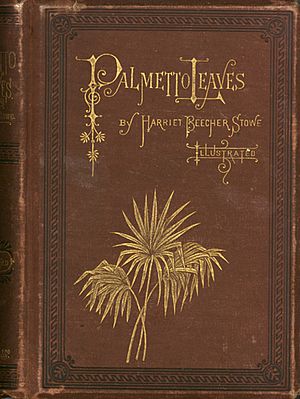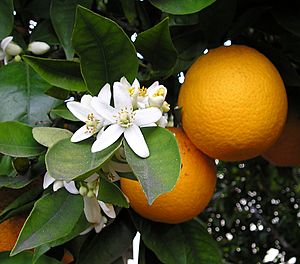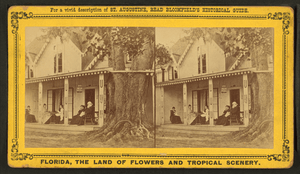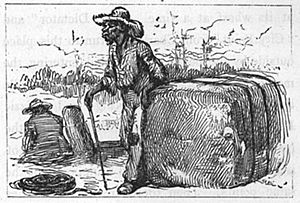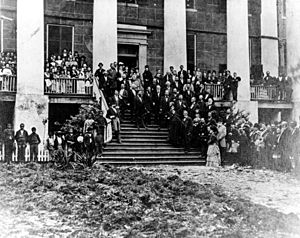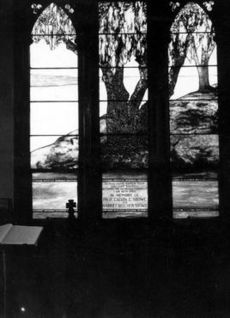Palmetto Leaves facts for kids
Palmetto Leaves is a special kind of book written by Harriet Beecher Stowe. It's partly a memoir, which means it tells about her own life and experiences. It's also a travel guide about her winters in Mandarin, Florida. The book was published in 1873.
Harriet Beecher Stowe was already very famous for writing Uncle Tom's Cabin in 1852. She came to Florida after the U.S. Civil War (1861–1865). She bought a large property near Jacksonville to help her son recover from war injuries and start a new life. Stowe loved the area so much that she bought her own small house and orange grove. She spent her winters there until 1884.
Parts of Palmetto Leaves first appeared in a newspaper owned by Stowe's brother. They were a series of letters and stories about life in northeast Florida. Stowe felt it was her duty to help newly freed African Americans. She wrote about her efforts to start a school and a church in Mandarin for them. The book also describes the beauty of Florida and its mild weather. However, she warned readers about very hot summers and cold spells in winter.
Stowe wrote this book for her family, friends, and people in New England. They often asked her for advice about moving to Florida, which was mostly wild at the time. Even though Palmetto Leaves is a smaller work compared to her other books, it was one of the first travel guides about Florida. It helped start Florida's first big wave of tourism and new homes in the 1880s.
Contents
Harriet Beecher Stowe's Florida Story
A New Start in Florida
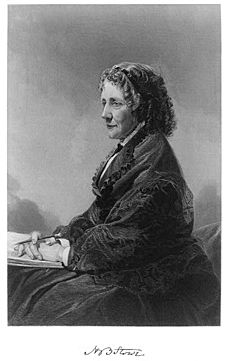
By 1867, when Harriet Beecher Stowe (1811–1896) moved to Florida, she was known worldwide. Her novel Uncle Tom's Cabin, published in 1851–1852, strongly spoke out against slavery in the United States. Stowe's strong feelings against slavery came from her deep Christian faith. She grew up as the daughter of a Presbyterian minister, and many of her brothers also became ministers.
In 1860, Stowe's son, Frederick "Fred" William Stowe, joined the army. He was promoted to lieutenant. In 1863, he was hurt in the Battle of Gettysburg, suffering a head wound. This caused him severe headaches, and he had to leave the army.
In 1866, Fred met two farmers who had been soldiers in Florida. They told him that land there was cheap and plentiful. They also said that many recently freed African Americans were available to work for low wages. When Fred told his mother, Stowe and her husband, Calvin Ellis Stowe, saw it as a great chance for Fred to get better.
Stowe bought a cotton plantation near Orange Park, south of Jacksonville, for $10,000. It was called Laurel Grove. She hoped Fred would manage the property as he recovered. Stowe also wanted to help the newly freed people. She believed it was important to help them learn and grow. She saw Florida as a place where she could do "Christ's work on earth" by helping these people.
Florida was not very populated or developed back then. The school system was in chaos after the Civil War. In 1860, there were no official schools for black children, and slaves were not allowed to be educated. However, freed black people saw education as a key to better opportunities.
Falling in Love with Mandarin
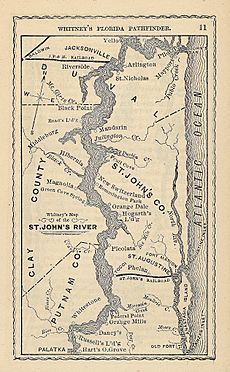
In early 1867, Stowe followed her son to Florida. She found that the warm weather helped her write more. She quickly fell in love with Florida, feeling "young & frisky." One day, she and Fred rowed across the St. Johns River to Mandarin to get mail. There, Stowe saw a small house with an orange grove and instantly loved it.
Stowe felt a strong connection to Florida's relaxed way of life, which was different from her busy life in New England. She even thought about how the warm climate might have changed famous writers if they had lived there.
Unfortunately, Fred's plantation, Laurel Grove, failed within a year. Fred was new to farming and made bad deals. A cotton-worm infestation also ruined most of the crop. Stowe realized the business was a failure. Fred then went to a recovery center in New York. Around 1867, Stowe bought the cottage and orange grove in Mandarin for herself.
Oranges were a luxury in northern cities. Stowe's new orange grove could bring in a good income. She worked on improving her new home, adding wallpaper and a veranda that wrapped around a giant oak tree. The house was big enough for up to 17 family members and friends.
From 1868 to 1884, Stowe divided her time between her home in Hartford, Connecticut, and her house in Mandarin. Each year before Christmas, she would pack up her Hartford home and ship everything to Florida. In Hartford, she was always busy with requests. But in Mandarin, she could relax and write for at least three hours a day.
Palmetto Leaves: A Look Inside
Stowe continued to be active, giving speeches, writing, and traveling while wintering in Mandarin. Instead of a new novel, she put together a collection of articles about Florida and letters to her family in New England. Some of these were first printed in Christian Union, a newspaper started by her brother Henry Ward Beecher.
Palmetto Leaves has twenty chapters, and their tone changes depending on who Stowe was writing for. Chapters like "Buying land in Florida" and "Florida for Invalids" were for general readers thinking about moving there. Other essays, like "Flowery January in Florida" and "St. Augustine," described the best sights. More personal chapters, such as "A Letter to the Girls," shared details about her daily life in Mandarin. Stowe also wrote about the lives of newly freed slaves. The last two chapters, "Old Cudjo and The Angel" and "Laborers of The South," focused entirely on this topic.
Palmetto Leaves was not Stowe's first travel book. She had written Sunny Memoirs of Foreign Lands in 1854 about her trip to Europe. Stowe often saw things in a positive light. She explained that she wanted to give readers a pleasant picture of life, just as she saw it.
Because little was known about Florida, Stowe's book helped show it as an exciting place with natural wonders. It was said to have powers that could improve health. Biographer Forrest Wilson believes Palmetto Leaves (published in 1873) was the first book to truly promote Florida. Stowe had originally wanted to call the book Orange Blossoms because she loved oranges so much. But she changed it to Palmetto Leaves to better represent the many palm trees in the region.
Important Ideas in the Book
Helping Others and Building Community
In Palmetto Leaves, Stowe shares stories that teach about helping others. For example, she tells about a stray dog on a boat and compares caring for such animals to Christian ideas of helping the poor.
Stowe saw the orange tree as a symbol for her work in Florida. She called it "the fairest, the noblest, the most generous" tree. She compared it to her goal of educating newly freed slaves. When she first arrived in Mandarin, religious services were held in her home. Her husband led the services, and Stowe taught Sunday School to both black and white children.
In 1869, Stowe bought land to build a church for her neighbors. This building would also serve as a school for children and freed slaves. She faced challenges with government rules, but the building was finished within a year. A teacher from New York was hired. Sadly, the building later burned down, likely due to carelessness, though some think it was arson. This deeply upset Stowe.
Despite the setback, Stowe and the community worked to rebuild the church. They also gave spelling books to local black people who were eager to learn. Stowe was sad to see children who wanted to learn growing up without education.
Life in Florida and Mandarin
The entrance of the St. Johns from the ocean is one of the most singular and impressive passages of scenery that we ever passed through: in fine weather the sight is magnificent. —Harriet Beecher Stowe: Palmetto Leaves, p. 15
From her first visit, Stowe was very impressed with Florida. In Palmetto Leaves, she praises Florida's beauty in January, describing its citrus fruits and flowers. She writes about the many plants, dedicating chapters to yellow jessmines and magnolia flowers. She also describes watching sugarcane being pressed into sugar, visiting neighbors with her mule named Fly, and exploring the woods. She kept a cardinal bird and four cats, though she later reported the cats had died.
Stowe also made sure to tell readers that Florida wasn't perfect. She compared New England's strict nature to Florida's relaxed, "indulgent old grandmother" nature. She warned that Florida has occasional freezing weather, insects, snakes, and people who disagree. She also mentioned that illnesses like Malaria were common. Stowe advised people thinking of moving to Florida to consider all these things carefully.
Stowe wrote about her boat trips on the St. Johns River and Julington Creek. She described the animals she saw, like alligators, "water-turkeys" (Anhinga anhinga), and "fish-hawks" (Pandion haliaetus). Stowe loved animals. She always brought her dogs, cats, and birds with her when she moved from Hartford to Mandarin each year.
She also cared about wild animals. She was upset by hunters who shot animals just for fun. She believed it was wrong to kill creatures that "enjoy" life and can suffer. In 1877, she wrote a pamphlet asking people to stop killing Florida's wading birds. Their feathers were being sold for high prices to decorate women's hats.
Stories of Newly Freed Slaves
The last two chapters of Palmetto Leaves talk about the newly freed slaves in Florida. Stowe describes two strong women. One, Minnah, was a field worker who tried domestic work. Stowe found her very direct in her speech. Minnah eventually returned happily to working in the fields. Another woman, Judy, was more relaxed and often took time off. Stowe thought their work habits were due to poor training from slavery. She believed that truly talented and hardworking black laborers had moved on to jobs where they could earn more.
However, Stowe praised a riverboat stewardess named Commodore Rose. Rose had been a slave but was freed for saving her captain's life. She continued to work for him. Rose knew the river and its history very well. Everyone on the boat respected her opinions.
Stowe also tells the story of Old Cudjo, a man on a Mandarin dock who had been cheated out of his land. Old Cudjo and his community of former slaves were so hardworking and honest that they won over their white neighbors. A local justice of the peace helped Old Cudjo get his land back.
Stowe's final chapter argues that black people should be hired to help develop Florida. She believed they were better suited for working in the hot sun, more resistant to malaria, and eager to learn. She also shared her observations about their culture, describing their night festivities and informal church services.
After the Book Was Published
Stowe's writings about Florida were noticed by important people. Her brother Charles bought land in Florida too, near Tallahassee. In 1874, Stowe and some investors met with Governor Marcellus Stearns. They were greeted with cheers at the state capitol building.
In 1882, Stowe bought land in Mandarin to build the Mandarin Church of Our Saviour. She attended its dedication. In 1884, the Stowe family left Mandarin for good because Calvin's health was failing. He died two years later. Stowe wanted to add a stained glass window in his memory at the Mandarin church.
A severe frost in 1886 damaged Florida's orange industry, causing Mandarin's economy to decline. In 1916, a beautiful stained glass window by Louis Comfort Tiffany was installed in the Church of Our Saviour. It showed a large oak tree overlooking the river. The church and Mandarin residents raised money for the window. Local black churches and residents also helped, giving what they could because they remembered Stowe teaching some of them to read. The window likely cost Tiffany $850, and he probably made no profit because he liked the design and its meaning.
Beneath the window were words from a hymn Stowe wrote: "In that hour, fairer than daylight dawning/ Remains the glorious thought, I am with Thee." The school Stowe supported closed in 1929. After Stowe left, her house became a lodge named after her. It closed in the 1940s and was later replaced by a new home. The 500-year-old oak tree that Stowe built around still stands today.
The stained glass window became a tourist attraction. However, in 1964, Hurricane Dora destroyed the Church of Our Saviour, including the window. Across the street is the Mandarin Community Club, which was the former school Stowe supported. It is now listed on the National Register of Historic Places. Mandarin has grown into a suburb of Jacksonville.
Artist Christopher Still created a painting called The Okeehumkee on the Oklawaha River. It hangs in the Florida House of Representatives. This painting is part of a series showing Florida's history and culture. In it, Palmetto Leaves is shown next to a large alligator and a hollow tree trunk, with a riverboat passing through a swamp.


